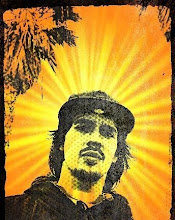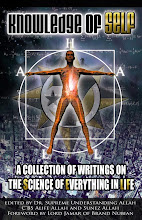 (Pictured at right is poet Willie Perdomo)
(Pictured at right is poet Willie Perdomo)
I've commented many times on the mindset amongst Original people that our experience in a predominately white Judeo-Christian society produces. It can only be understood as a form of "schizophrenia" if we are to use Euro-psychological terms. This is because we live in a society of contradictions. We are constantly told one thing and shown another. We go to hospitals to tend to our health needs and are given the worst food. We send our children to karate class only to encourage them to not fight. We prosecute urban pharmaceutical entrepeneurs but not the corporate ones. We are told to work hard and go to school and have a family when society and it's trappings are in direct opposition to any of that. There are jobs, cheap, low wage jobs which hardly afford someone to realistically go to school or maintain a healthy family without working two or three of them. And we then become trapped in the chasing of illusions all with the "managers" of society's determination for us to become more mindless and better producer/consumers. We are told we can be anything we want. But our overall living conditions show otherwise. So we have become schizophrenic in many ways. This is one of my reasons for my refusal to refrain from using the "n-word". Our schizophrenic tendencies begin to manifest so within all the strides we make and progress we achieve we still do "nigga shit". We have a subconscious voice that speaks to us from a different quandrant of the brain, a voice that stirs the restless of colonization in all of us. So I can't take a so-called the movement seriously. And the reason is because I understand the reality and the depths of the conditioning of America and White Supremacy. I'm not shamed nor afraid to call it what it is. The movement to ban the word "nigger" is more so perpetrated by the middle class as a baby boomer's (house nigga mentality- that is those bought out and pacified by the Civil Rights Movement of the 1960's) reaction to the frustrated and agitated outspokeness of the young, the "field niggas". I appreciate the effort to put a blockade on buffoonery in entertainment. However, we still act like buffoons in other areas and sectors of society. It appears that our image in entertainment is all we care about, considering our history as entertainers for white folks.
The schizophrenia isn't "race" based, as in so-called African American versus Latinos and one wanting to be like the other, as the poem below may allude to. The poem from Willie Perdomo actually speaks to a truth, that there is no difference between so-called African Americans and so-called Latinos. We both have ancestors in Africa and in Native America. We are both Original people and are in fact ONE people-ONE race, in light of Allah's understanding. After all there are only two people on the planet according to our (the Nation of Gods and Earths) paradigm- the Original people and the Colored people. People of color and non-people of color. The schizophrenia is based in us living other than who we are. Remember it is largely due to environmental influences that we see each other as completely different. Yet, these environmental influences encourages a preference for things Euro-centric and the yearn to kindle an affinity for Euro-centrism and those who usher it. I-self have been called "too black" by some Latinos because I don't "sound" Latino. They thought I sounded "black" and also because I enojy hip-hop music and/or wear my clothes etc. Unfortunately, they are ignorant to their history and the "Latin" contribute to hip-hop from day one. And as well, they being unfamiliar with who I am, were ignorant to my upbringin' in a predominately African-American neighborhood which fostering a clearer understanding of our relationship to one another. Whereas other Latinos may only know of their African-American brothers and sisters from BET or what they held on to from bad experiences. And the same goes for African Americans and their perspectives on Latinos, and their isolation from us. However, my life experience allowed me to understand and appreciate Original peoples our are various cultural manifestations and expressions beyond the limitations of typical Latin upbringing. For instance, to take a light skinned Latino and understand him or her as no different from a "high yellow" brother or sister from Louisiana and the only difference being in the language they speak. Other than that, both peoples are the results of Indian, African and the mid-atlantic malay that mingled the slave traders and masters blood in us.
Nigger-Reecan Blues
by Willie Perdomo (for Piri Thomas)
Hey, Willie. What are you, man?
No, silly. You know what I mean: What are you?
I am you. You are me. We the same. Can't you feel our veins drinking the same blood?
-But who said you was a Porta Reecan?
-Tu eres Puerto Riqueno, brother.
-Maybe Indian like Gandhi Indian.
-I thought you was a Black man.
-Is one of your parents white?
-You sure you ain't a mix of something like
-Portuguese and Chinese?
-Naaaahhh. . .You ain't no Porta Reecan.
-I keep telling you: The boy is a Black man with an accent.
If you look closely you will see that your spirits are standing right next toour songs. You soy Boricua! You soy Africano! I ain't lyin'. Pero mi pelo eskinky y kurly y mi skin no es negra pero it can pass. ..
-Hey, yo. I don't care what you say - you Black.I ain't Black! Everytime I go downtown la madam blankeeta de madesson avenue sees that I'm standing right next to her and she holds her purse just a bit tighter. I can't even catch a taxi late at night and the newspapers saythat if I'm not in front of a gun, chances are that I'll be behind one. I wonder why. . .
-Cuz you Black, nigger.
I ain't Black, man. I had a conversation with my professor. Went like this:
-Where are you from, Willie?
-I'm from Harlem.
-Ohh! Are you Black?
-No, but-
-Do you play much basketball?
Te lo estoy diciendo, brother. Ese hombre es un moreno!
Miralo!
Mira yo no soy moreno! I just come out of Jerry's Den and the
coconut spray off my new shape-up sails around the corner, up to the Harlem River and off to New Jersey. I'm lookin' slim and I'm lookin' trimand when my homeboy Davi saw me, he said: "Como, Papo. Te parece como un moreno, brother. Word up, bro. You look like a stone black kid."
-I told you - you was Black.
Damn! I ain't even Black and here I am sufferin' from the young Black man's plight/the old white man's burden/and I ain't even Black, man/a Black man/I am not/Boricua I am/ain't never really was/Black/like me. . .
-Leave that boy alone. He got the Nigger-Reecan Blues
I'm a Spic!
I'm a Nigger!
Spic! Spic! No different than a Nigger!
Neglected, rejected, oppressed and depressed
From banana boats to tenements
Street gangs to regiments. . .
Spic! Spic! I ain't nooooo different than a Nigger.



























